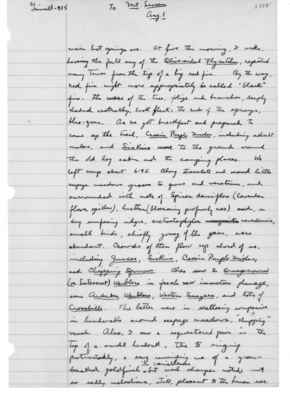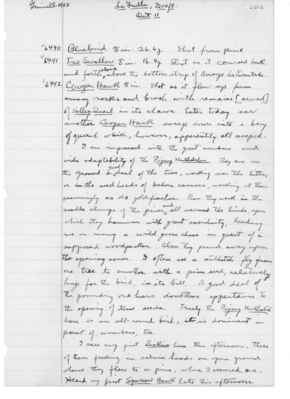Pages That Mention Siskins
1925: Joseph Grinnell's field notes
S2 Page 88
Collector: Grinnell - 1925 Location: To Mt. Lassen Date: Aug. 1 Page Number: 2538 main hot springs are. At five this morning, I woke, hearing the full song of the Olive-sided Flycatcher, repeated many times from the tip of a big red fir. By the way, red firs might more appropriately be called "black" firs: the mass of the tree, folige [sic] and branches, deeply shaded centrally, look black, the ends of the sprays, blue-green. As we got breakfast and prepared to come up the trail, Cassia Purple Finches, including adult males and Siskins came to the ground around the old log cabin and the camping places. We left camp about 6:45. Along streamlets and around little seepage meadows grown to grass and veratrum, and surrounded with mats of Spirea densiflora (lavender flower spikes), heather (blossoming profusely now) and on dry surfacing ridges, arctostaphylos nevadensis, small birds, chiefly young of the year, were abundant. Crowds of them flew up ahead of us, including Juncos, Siskins, Cassia Purple Finches, and Chipping Sparrows. Also saw 2 Orange-crowned (or Lutescent) Warblers in fresh new immature plumage, some Audubon Warblers, Western Tanagers, and lots of Crossbills. The latter were in scattering companies in hemlocks around seepage meadows, "chupping"(?) much. Also, I saw a sequestered pair in the top of a small hemlock. The [male sign] singing protractedly, a song reminding me of a green backed goldfinch in variableness but much sharper noted; not so sadly melodious, still pleasant to the human ear.
S3 Page 39
Collector: Grinnell - 1925 Location: La Grulla, 7200 ft. Date: Oct. 11 Page Number: 2582 6490 Bluebird (male sign) im. 26.6g. Shot from pine. 6491 Tree Swallow (male sign) im. 16.4g. Shot as it coursed back and forth alone above the bottom strip of Arroyo La Encantada. 6492 Cooper Hawk. (male sign) im. Shot as it flew up from among rocks and brush with remains [saved] of Valley Quail in its claws. Later today saw another Cooper Hawk sweep down into a bevy of quail which, however, apparently all escaped. I am impressed with the great numbers and wide adaptability of the Pigmy Nuthatches. They are on the ground a good deal of the time, working over the litter; or in the seed heads of Salvia carnosa, working at them seemingly as do goldfinches. Then they work in the needle clumps of the pines, and all around the limbs upon which they hammer with great assiduity, leading me on many a wild goose chase in quest of a supposed woodpecker. Also they pound away upon the opening cones. I often see a nuthatch fly from one tree to another with a pine seed, relatively huge for the bird, in its bill. A good deal of the pounding one hears doubtless appertains to the opening of these seeds. Truly the Pigmy Nuthatch here is an all-round bird; it is dominant in point of numbers, too. I saw my first Siskins here this afternoon, three of them feeding in salvia heads on open ground whence they flew to a pine, where I secured one. Heard my first Sparrow Hawk late this afternoon.

